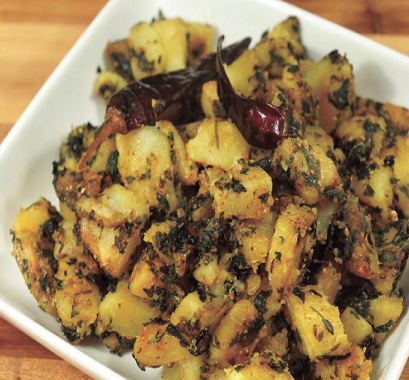Mama’s Punjabi Recipes – Aaloo Methi (Sauteed Potatoes & Fenugreek)
Methi (fenugreek) is a vegetable that, when dried, is also used as a spice for flavoring other dishes, like raita (yogurt sauce) or paranthas (crispy flat breads). In this way, it is unique among all the vegetables that are used in Indian cooking, which comes from the raw vegetable itself being no more than the small leaves that grow on long tender stems.
Methi is a plant with three small oblong leaflets that is grown in many countries around the world in semi-arid climates, especially in South Asia. It is used by the Iranians in their national dishes, by Ethiopians and Eritreans for treating diabetes and by Jews during celebrations of their New Year (Rosh Hashana). It is grown all across western and northern India, with Rajasthan alone producing 80% of India’s output.
Though sold in bundles with the roots still attached, the leaves are removed from the stems and relished for their bitterness and sweet aroma that add extra flavor to the foods they are mixed with. About the only drawback to cooking with fresh methi is that it is labor intensive to pick the leaves and wash them thoroughly to get rid of the dirt around the stems. For this reason, it is widely available now in dried form in sealed packets. Still, you need a lot of methi flakes or leaves for a dish, as it shrivels up into a small pile after cooking.
Methi is used in making pickles, daals (lentils), paranthas and vegetable dishes, but by far the most widely used and popular dish, as least in the Punjab, is aaloo methi (sautéed potatoes and fenugreek), best eaten with hot roti and a bowl of plain yogurt. If you are not fond of eating potatoes, you will certainly love the flavor that methi adds to them and eat them all up! Methi is hard to resist, though some western people may find it is an acquired taste.
Used from ancient times in India, methi is also known for its medicinal qualities in home remedies which claim that it can soothe digestive problems, help control blood sugar and so reduce diabetes as well as cholesterol and is also and is an ingredient in some medicines in India. Methi is high in carbohydrates, protein and minerals.
Ingredients:
4 medium bundles of methi (fenugreek) or use two packets of dried methi
4 large aaloo (potatoes), peeled new potatoes are best
2 tbsp tael (vegetable or olive oil)
Spices to taste: namak (salt), mirch (red pepper), haldi (turmeric) powder
Directions:
1. Open the methi bundles and pick off the top portion of each stem with the leaves. Discard the rest of the stems.
2. To the masala add the rice and then the water, cover the pot and let it all boil for 5 minutes over high heat. 1.Place the picked leaves and tops in a strainer and wash thoroughly to remove any dirt. Let stay for the water to drip.
3. Peel the potatoes and then cut into medium pieces. Wash these and let them drip too.
4. In a wok or kadai or large skillet, warm the oil over medium heat and add the turmeric. Stir and let in warm up well.
5. Throw in the cut potatoes and the methi tops. Stir, then add the salt and pepper to taste. Now cover and let it sit for 5 minutes.
5. Reduce the heat to low, uncover and check if the potatoes are cooked and coated with the methi. If not, then cover again and let it cook for a few minutes more on low. Be sure to check that the methi and potatoes are not sticking to the pan or getting burnt.
5. Check again and if cooked, turn off the heat and leave uncovered for some minutes so that water does not condense on the dish. This dish is best when served with hot wheat rotis and plain yogurt.
Shakuntla Malhotra is a skilled cook of Punjabi dishes made in the old-fashioned style that she learnt as a young woman in her ancestral home in Lyallpur, India before it became part of Pakistan after the Partition in 1947. People have often admired her cooking for its simplicity and taste that comes with each mouthful. Even in her mid-eighties, she continues to cook daily and agreed to share some of her delectable Punjabi recipes.
***
MAMA’S TIP OF THE WEEK
PREPARING VEGETABLES FOR COOKING
Many times, I have heard of people who add water when cooking vegetables and then finding that the dish comes out too watery and the flavor is diluted and not well infused in the dish.
This is because the vegetables themselves give off a lot of water as steam when they are cooked and they do not need any extra water to start with. After washing the vegetables, always let them drain, then add to the pan and let them cook covered to begin with under medium to high heat. Later, uncover and check if the veggies are tender and you will see how much water vapor comes out as steam. If the veggies are not tender, then add two or three table spoons of water, place the cover back on and let them cook under low heat.
***


